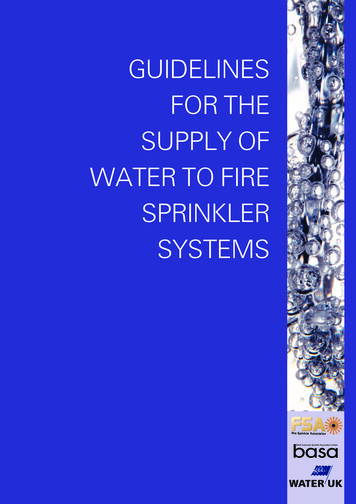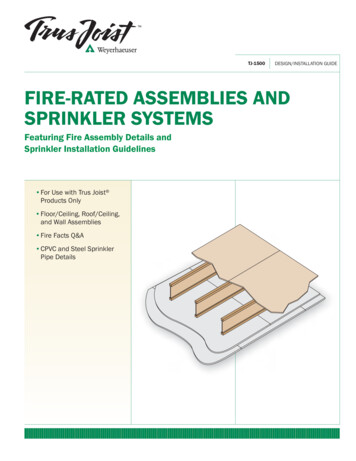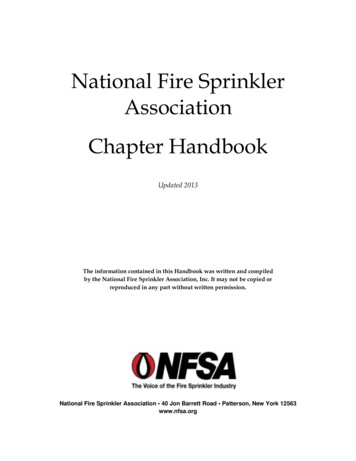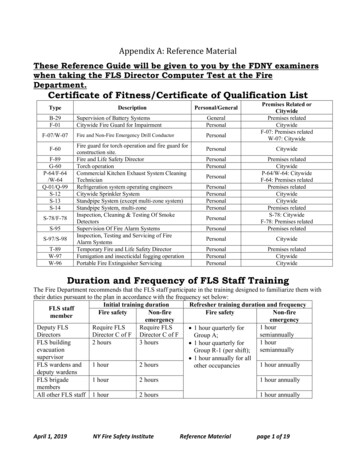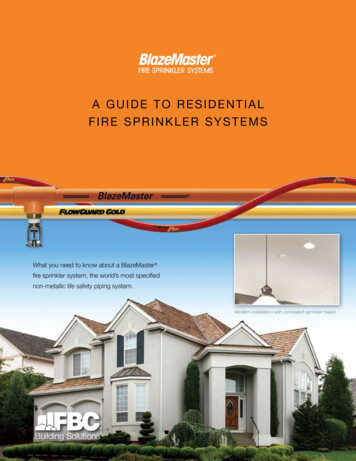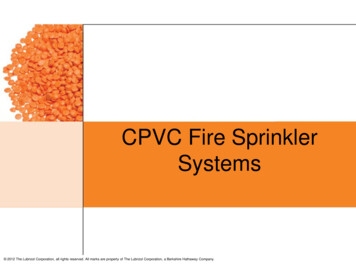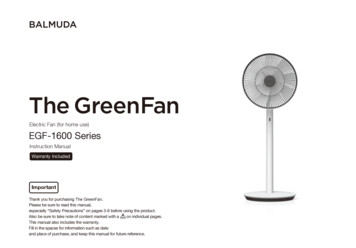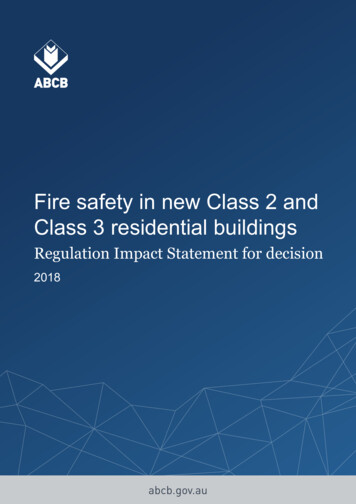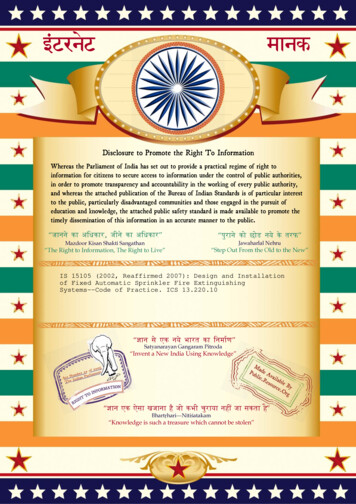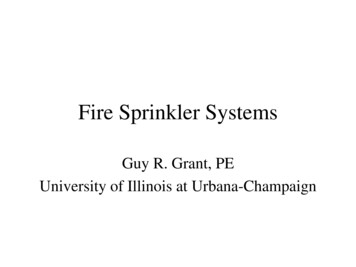
Transcription
Fire Sprinkler SystemsGuy R. Grant, PEUniversity of Illinois at Urbana-Champaign
Why would I want to pay for afire protection system in mybuilding when I have smokedetectors?
For people and facilitiesA fire protection system does more than protect thebuilding. It is also a key component in the lifesafety strategy against fires. It both notifies theoccupants of a fire and it suppresses the fire. Forinstance, if the building is a low-rise office orschool building, fire sprinklers are proven to begreater value than smoke detectors. Consequently,having sprinklers in these buildings will allow thedesigner longer travel distances to exits whereashaving smoke detectors in these buildings affordsthe designer no such benefits.
Importance of Fire Sprinklers Automatic sprinklers are widely recognized as thenumber one tool of fire protection In over one hundred years of use, there has neverbeen a multiple fatality of building occupants fromfire in a building with a properly designed,installed, and maintained sprinkler system Sprinklers respond to a fire while it is still small,preventing the fire from developing into a majorthreat
How reliable are sprinklers? Records of fires in buildings withsupervised automatic fire sprinkler systemshave indicated successful extinguishment orcontrol in more than 99% of fire incidents.No other fire protection system or featurehas a comparable record of reliability. Most fires are contained by one or twosprinklers.
What about water damage? Because sprinklers attack the fire while it is stillsmall, the total amount of water needed for firesuppression is small (often less than 50 gallons perminute) Without sprinkler protection, a fire is permitted togrow and the fire department will typically applyhundreds of gallons of water per minute during theiroperations For this reason, total amounts of water used insprinklered buildings approximate one-tenth theamounts used for fires in nonsprinklered buildings
What about water damage? The likelihood of a sprinkler discharging water inthe absence of a fire is very small Each model of sprinkler is subjected to rigorouslaboratory tests to guarantee long-term integrity,and every single sprinkler is hydrostatically testedat twice the maximum system water pressure priorto leaving the factory Sprinkler guards should be used in environmentswhere sprinklers could be damaged
Aren’t Sprinkler SystemsExpensive? No, in fact sprinklers can often reduce the totalcost of construction Typically, sprinkler systems can be installed forabout 1% of building cost, or less than 2 persquare foot If the decision to install sprinklers is made earlyenough in the planning process, sprinklers canactually reduce total construction costs through theuse of code incentives or “trade-ups”
Aren’t Sprinkler SystemsExpensive? In recognition of the superior fire protectionafforded by sprinklers, codes permit reductions infire resistance ratings, longer exit travel distances,and a wider range of interior finish materials insprinklered buildings Insurance rates are substantially less forsprinklered facilities These incentives make it possible to build a saferbuilding for less money
The best fire protection system is
the one that works when it’sneeded.
Reliability Chose the appropriate system for the application. The right system is typically the most costeffective one from a risk management perspective. Design the simplest system that can be used. Proper inspection, maintenance, and testing is amust.
Sprinkler System Components Basic components:––––SprinklersSystem pipingA dependable water sourceMost systems also require an alarm andsystem control valves
Sprinkler Head Components The typical sprinklerconsists of a frame,thermal operatedlinkage, cap, orifice, anddeflector Styles of eachcomponent may varybut the basic principlesof each remain the same
Sprinkler Head Components Frame– The frame provides the main structuralcomponent which holds the sprinkler together.– The water supply pipe connects to the sprinklerat the base of the frame– The frame holds the thermal linkage and cap inplace, and supports the deflector duringdischarge
Sprinkler Head Components Thermal linkage– The thermal linkage is the component whichcontrols water release– Under normal conditions the linkage holds thecap in place and prevents water flow– Common linkage styles include soldered metallevers, frangible glass bulbs, and solder pellets
Sprinkler Head Components Cap– The cap provides the water tight seal which islocated over the sprinkler orifice.– This component is held in place by the thermallinkage– Operation of the linkage causes the cap to fallfrom position and permit water flow
Sprinkler Head Components Orifice– A machined opening at the base of the sprinkler frame– It is from this opening which extinguishing water flows Deflector– The deflector is mounted on the frame opposite theorifice– The purpose of this component is to break up the waterstream discharging from the orifice into a more efficientextinguishing pattern– Deflector styles determine how the sprinkler is mounted
Types of Sprinkler Heads Common sprinkler mounting styles includePendentUprightSidewall
How does a fire sprinkler work?The typical sprinkler head consists of aplug held in place by a trigger mechanism.The most common type of trigger is aglass bulb filled with aliquid that expandswhen heated.A less commonly usedtype of trigger consistsof two metal plates held togetherby a solder link. When the soldermelts, two spring arms pull theplates apart, releasing the plug.
How does a fire sprinkler work?The liquid in the glass bulb is designedto expand ad break the tube at a certaintemperature. The most common aredesigned to break at 155 degrees.
How does a fire sprinkler work?The plug is forced out by the pressurizedwater behind it and deflected away. Thewater sprays over the deflector plate whichis designed to distribute it in an evenpattern directly over the source of the fire.Contrary to what is sometimes shown ontelevision shows, all sprinklers in thebuilding do not operate simultaneously.
Sprinkler System Components Other major components include– Control valves : A sprinkler system must becapable of shut down after the fire has beencontrolled, and for periodic maintenance andmodification. Control valves provide thisfunction.– Alarms : Alarms alert building occupants andemergency forces when a sprinkler water flowoccurs. Alarms are also provided to alertbuilding management when a sprinkler valve isclosed
Sprinkler System Components Drain and test connections : Most sprinklersystems have provisions to drain pipes duringsystem maintenance. Test connections are usuallyprovided to simulate the flow of a sprinkler flow,thereby verifying the working condition of alarms Fire hose connections: Fire fighters will oftensupplement sprinkler systems with hoses.Firefighting tasks are enhanced by installing hoseconnections to sprinkler system piping.
Sprinkler System Components Backflow preventer: The normal backflowrequirement for an automatic fire sprinkler systemis a double check valve assembly. A backflowpreventer prevents the backflow of polluted waterinto the potable water supply. A reduced pressuretype backflow preventer is required if the pipingdoes or can contain hazardous substances.
Types of sprinkler systems WetDryDelugePre-actionWater Mist
Wet Pipe Sprinkler Systems A wet pipe sprinkler system uses automaticsprinklers attached to a piping system filled withwater and connected to a water supply so that waterdischarges immediately from sprinklers opened byheat from a fire Most common type of system Used for buildings where there is no risk of freezing Quick to react because water under pressure isalways in the pipework Wet pipe systems required for multi-story or highrise building and for life safety, such as thoseinstalled in shopping centers
Dry Pipe Sprinkler System A dry pipe sprinkler system is one in which pipesare filled with pressurized air, rather than water This air holds a remote valve, known as a dry pipevalve, in a closed position The dry-pipe valve prevents water from enteringthe pipe until a fire causes one or more sprinkler tooperate. Once this happens, the air escapes and thedry pipe valve releases. Water then enters the pipe, flowing through opensprinklers onto the fire. Used where there is a risk of frost damage WARNING: Frequent operation of compressormeans trouble! Get help immediately!
Deluge Sprinkler Systems The arrangement of deluge system piping issimilar to a wet or dry pipe system with twomajor differences:– Standard sprinklers are used but they are all open.The activating elements (fusible link or glass bulb)have been removed so that when the control valve isopened, water will flow from all of the sprinklersand deluge the are with water– The deluge valve is normally closed. The valve isopened by the activation of a separate fire detectionsystem
Deluge Sprinkler Systems The detection system is installed in thesame area as the sprinklers Deluge systems are used in places that areconsidered high hazard areas such as powerplants, aircraft hangars, and chemicalstorage or processing facilities. Deluge systems are needed where highvelocity suppression is necessary to preventfire spread.
Pre-action Sprinkler Systems The pre-action sprinkler system is similar to thedeluge sprinkler system except that the sprinklersare not open; they are closed sprinklers withfusible links or glass bulbs For a single interlocked system, the pre-actionvalve is normally closed and operated by aseparate fire detection system. Activation of a firedetector will open the pre-action valve, allowingwater to enter the system piping.
Pre-action Sprinkler Systems Water will not flow from the sprinklers untilheat from the fire activates the operatingelement in individual sprinklers Used where it is not acceptable to have thepipes full of water until there is a fire (e.g.computer suites) Double interlock only for areas subject tofreezing!
Water Mist Systems Water mist systems include many of the sameelements found in automatic sprinkler systems, butthe application of water is different These systems use very fine water spray (mist)that absorbs heat, displaces oxygen, or blocksradiant heat to control, suppress, or extinguishfires Water mist systems are typically used for smallconfined areas, such as inside equipmentenclosures or cabinets
Other related systems Standpipe system Clean Agent system
Standpipe System Standpipes are an arrangement of piping,valves, hose connections and alliedequipment installed in a building orstructure with the hose connections locatedin such a manner that the water can bedischarged through attached hoses andnozzles
Standpipe Systems Standpipe systems provide fire hoseconnections within a building or industrialcomplex Hose connections are fed by a supply pipe(often referred to as a riser) and are locatedthroughout the facility, usually on eachfloor
Standpipe Systems Four methods in which water is supplied tostandpipes:– Wet standpipe in which water is supplieddirectly from a water main (or through a firepump if higher pressures are needed). Watersupply valve is always open and the system isalways under water pressure– Dry manual standpipe in which there is nopermanent water supply. Water must besupplied by the fire department
Standpipe Systems Four methods (cont.)– Dry standpipe in which a connection to a watermain is provided by a manual control valvewhich is kept closed. The standpipe systemremains dry until needed– Dry automatic standpipe in which the valvecontrolling water to the system is automatic, aswith a dry pipe valve. Water is admitted to thesystem when a hose valve is opened and airpressure in the system is released
Clean Agent System Commonly comprised of inert gases or saferHCFCs Can dilute the amount of oxygen to preventcombustion or can cool reactants on themolecular level below the heat of combustion.
Clean Agent Systems Clean, nonconductive, noncorrosive – goodfor important electronics Environmentally friendlier than Halon React quickly – triggered by smoke and/orheat detectors High first cost – costly to recharge One shot to extinguish fire - best if coupledwith sprinklers
Design of Sprinkler Systems Sprinkler system piping is installed inaccordance with one of two methods:– Pipe schedule system– Hydraulically designed system Pipe schedule systems are not allowed fornew installations The first step is to determine theclassification of hazard
A Design Application Large drop sprinklers attack the fire plumethat develops in atriums due to the delay insprinkler operation from the height issue Ordinary Group II Hazard Classification(.20 gpm/ft2 over 1500 ft2) provides anadequate amount of water to suppresstypical atrium fuel loadings
Occupancy Classifications The occupancy or use of the building willpredominantly determine the type of systemrequired:– Light Hazard– Ordinary Hazard Group 1 Group 2– Extra Hazard Group 1 Group 2
Pipe – Schedule System The number of sprinklers fed by a givenpipe size is determined by schedules givenin sprinkler installation rules Installation rules vary with the occupancyof the area to be protected
Hydraulically Designed System Most sprinklers require 7 psi (minimum) tooperate Quick analysis:– Determine worst hazard (ex: Small officebuilding is Light Hazard throughout)– Select design density and corresponding area ofsprinkler operation (our ex: .10 gpm/ft2/1500 ft2)– Determine inside water demand (.1 x 1500 x 1.25 187.5 gpm)
Hydraulically Designed System Quick analysis (cont.):– Add pipe, fittings, devices, backflow preventer,and elevator losses5 5 4 (0.433 x15' ) 21 psi(pipe) (ftgs)(BFP)(elev.)– 21 7 psi 28 @ 187.5 gpm– Add 100 gpm for hoses– 28 @ 287.5 gpm at city
Hydraulically Designed System Note: Building square footage has littleeffect on the need for a fire pump.However, the hazard classification andbuilding height do have a significant effecton whether a fire pump is needed.
Do I really need a fire pump? Installing a fire pump is often the default ratherthan something that must prove it’s needed Many are not comfortable deciding if a fireprotection system can do without one. Fire pumps are great when needed but notdesired if not needed. Cost Reliability
How do I know if a pump is needed? Look at highest fire hazard classifications Look at available flow and pressure fromutility Look at building elevations Perform basic hydraulic calculations Can standpipe design be manual wet?
Basic Fire Pump Calculations
Basic Fire Pump CalculationsDensity Diversity
Basic Fire Pump Calculations
Basic Fire Pump Calculations54-0.6-4.0 (BFP)-17.3-15-7.010.1psi cushion
Fire Pump Selection Consider resulting city water pressure when pumpis flowing 150% of its rating (city water pressuremust not drop below 20 psi) Consider resulting system water pressure when atpump churn (standard fittings and components areonly rated for 175 psi) Jockey (maintenance) pump should be selected tomaintain system pressure above fire pump startingpressure
Water Supply Requirements Every automatic sprinkler system shall haveat least one automatic water supply Water supply treatment– Water supplies and environmental conditionswill be evaluated for the existence of microbesand conditions that contribute tomicrobiologically influenced corrosion (MIC)
Installation of Sprinkler Systems Basic requirements include– Position, location, spacing, and use of sprinklers Determination of the protection area of coverage Maximum/Minimum distance between sprinklers Maximum/Minimum distance of sprinkler from walls– System protection area limitations– Application of sprinkler types Requirements may vary depending on typeof system used For any system, pre-lubed groovedcouplings are recommended
Wet Pipe Sprinkler SystemRequirements Must be reliably heated. Overhangs andchases on exterior walls cannot be trusted Normal black steel piping is fine for wetsystems CPVC can be used in many applications
Dry Pipe Sprinkler SystemRequirements Gridded dry pipe system are not allowed Air pressure should be maintained on dry pipesystems throughout the year The compressed air supply should be from asource available at all times – Initial charge withNitrogen Galvanized black steel pipe Dry systems should be drained completely tominimize corrosion – No roll groove ends Use accelerators only when absolutely necessary
Inspection, Testing, &Maintenance of Sprinkler Systems Maintaining adequate fire protection systems is ascritical as the original decision to install these systems Because fire suppression, detection, and alarm systemsare generally not used on a routine basis, their state ofreadiness is not immediately apparent The periodic inspection, testing, and maintenance offire detection and suppression systems are essential toensure successful performance when these systems areneeded
Inspection Visual examination of the sprinkler systemto verify that it appears to be in operatingcondition and free of physical damage Visual examination of storage and generalenvironment surrounding sprinkler system
Inspection Sprinklers– Inspected from floor level annually– Should not show signs of leakage– Should be free of corrosion, foreign materials,paint, and physical damage– Should be installed in the proper orientation
Inspection Pipe and Fittings– Should be in good condition– Free of mechanical damage, leakage, corrosion,and misalignment– Piping should not be subjected to external loadsby materials either resting on the pipe or hungfrom the pipe
Inspection Hangers and Seismic Bracing– Should not be damaged or loose Gauges– Wet pipe systems : Should be inspectedmonthly to ensure that they are in goodcondition and that normal water supplypressure is being maintained– Dry, pre-action, and deluge systems : Should beinspected weekly to ensure that normal air andwater pressures are being maintained
Testing Sprinklers– Sample sprinklers submitted to a recognized testinglaboratory acceptable to the authority having jurisdiction forfield service testing– Test procedures repeated at 10-year intervals– If one sprinkler within a representative sample fails to meetthe test requirement, all sprinklers represented by thatsample shall be replaced Drains– Put ITC (Inspector’s Test Connection) for wet systems atthe riser. Reduces corrosion in piping, lessens chances ofobstructions to sprinklers and it makes testing easier– System main drain must discharge to a place that can acceptfull flow under pressure and gravity drain completely
Testing Pumps, alarms, and valves also need to be testedand exercised on schedule for reliability andlongevity. Keep records on all tests NFPA 25 provides descriptions of these tests andrecommended forms
MaintenanceFire protection systems require littlemaintenance when properly cared for. Sprinklers– Replacement sprinklers shall have the propercharacteristics for the application intended. Theyshould be the same type as the adjacent existingsprinklers.– A supply of spare sprinklers (never fewer than 6)shall be maintained on the premises so that anysprinklers that have operated or been damaged inany way can be promptly replaced Dry pipe systems shall be kept dry at all times.
Prevention and Control of InternalCorrosion in Sprinkler Systems Over the past years an increasing number ofleaks and other corrosion related problemshave been associated with microbial orbacterial activity in fire protection piping
Prevention and Control of InternalCorrosion in Sprinkler Systems What is Microbiologically InfluencedCorrosion (MIC)?– MIC is one of the many forms of corrosion thatcan affect sprinkler systems– MIC is not a new corrosion mechanism;however, its association to fire protectionpiping is relatively new
Prevention and Control of InternalCorrosion in Sprinkler Systems How does MIC affect sprinkler systems?– Because of its nature and the complexity of fireprotection piping, MIC is not easily controlledin fire protection systems– MIC can affect any piping within the sprinklersystem, however, branchlines and risers seem tobe more seriously affected
Prevention and Control of InternalCorrosion in Sprinkler Systems How does MIC affect sprinkler systems?– MIC generally results in the growth of biofilmsand nodules within the piping– Nodules and biofilm may result in increasedfriction loss, and affect the ability of the pipe tocarry the necessary flow– MIC may also affect sprinklers and valves, andblock water motor gongs, and alarm lines andother components of a fire protection system
Prevention and Control of InternalCorrosion in Sprinkler Systems How to protect sprinkler systems from MIC– Existing sprinkler systems: Investigate for possible corrosion problems andobstructed waterways, pinhole leaks, or other signs ofcorrosion in pipes, valves or sprinkler heads Flush sprinkler systems where investigation revealsobstructions of the waterway Replace any section of piping that contains obstructionsthat cannot become removed by flushing procedures* Reinvestigate systems for waterway obstruction annually.
Prevention and Control of InternalCorrosion in Sprinkler Systems How to protect sprinkler systems from MIC– New Sprinkler Systems: Use new, clean, coated pipe for all new sprinklersystem installations and retrofits Do not use chlorine for disinfecting purposes Do not leave open pipe exposed where it couldaccumulate dust, dirt, water and other residue prior toinstallation
Prevention and Control of InternalCorrosion in Sprinkler Systems How to protect sprinkler systems from MIC– New wet-pipe sprinkler systems: Avoid repeated cycles of system shutdowns wherethe system is drained and recharged Avoid air gaps (pockets) within the system, whichcan expose piping to dry/wet conditions. Air gaps canbe avoided by providing means for air release at thehighest point of each branchline
Prevention and Control of InternalCorrosion in Sprinkler Systems How to protect sprinkler systems from MIC– New dry pipe and pre-action systems: Avoid the use of roll grooved joints. Roll groovedjoints in a dry sprinkler system promote wateraccumulation that can result in preferred corrosionsites Install pipe with proper pitch to promote drainage ofall testing water and water vapor condensate withinpiping Keep low point drains clean and drain condensate asneeded to prevent water accumulation
Prevention and Control of InternalCorrosion in Sprinkler SystemsHeavy tubercle formation ina 8 in. sprinkler pipeCorrosion at roll groove in awet pipe system
Earthquake Protection Uncontrolled differential movement can causedamage when fire protection systems are notprovided in a systematic manner with thenecessary features that incorporate sway bracing,flexibility, clearances, and anchorage whereneeded The most common type of damage is waterdamage due to water leakage from brokenoverhead sprinkler piping or sprinklers, primarilydue to lack of sway bracing where needed
Earthquake Protection How to adequately protect sprinkler systemsfrom earthquake damage– Brace piping or equipment to minimizeuncontrolled differential movement betweenpiping or equipment and the structure to whichit is attached– Provide flexibility on piping systems and onother equipment where differential movementbetween portions of those piping systems orequipment is expected
Earthquake Protection How to adequately protect sprinkler systemsfrom earthquake damage– Provide clearance between piping or equipmentand structural members, walls, floors, or otherobjects so that potential damage from impact isminimized– Provide anchorage to minimize potential slidingand/or overturning
Earthquake Protection How to adequately protect sprinkler systemsfrom earthquake damage– Use appropriate types of pipe hangers and swaybracing, properly locate them, and properlyattach them to the structure to minimize thepotential for pullout– Use appropriate types of piping and pipejoining methods to minimize potential pipebreaks
What to do with a broken fire lineunder floor?1. Replaced RPZ with DDC BFP2. Fed 4” HDPE thru 6” DI pipe
References Factory Mutual Global Property LossPrevention Data Books National Fire Protection AssociationNational Fire Codes Pamphlets 13, 14 and25
- Standard sprinklers are used but they are all open. The activating elements (fusible link or glass bulb) have been removed so that when the control valve is opened, water will flow from all of the sprinklers and deluge the are with water - The deluge valve is normally closed. The valve is opened by the activation of a separate fire detection
